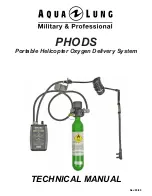
932512A / 0114
ORTEC
®
EASY-NIM
™
928 Suite
29
The following table shows which spectra are collected in the three possible ZDT modes.
Mode
Uncorrected
Spectrum
ZDT Corrected
Spectrum
ZDT Error
Spectrum
Off
(ZDT Disabled)
Yes
No
No
NORM_CORR
(ZDT–LTC Mode)
Yes
Yes
No
CORR_ERR
(ZDT–ERR Mode)
No
Yes
Yes
3.5.1.
Off — Uncorrected Spectrum Only
In this mode, only the uncorrected spectrum (live time and real time with dead-time losses) — also called the
live-
time-corrected
or
LTC
spectrum — is collected and stored in the
.SPC
file. The LTC spectrum can be used to determine
exactly how many pulses at any energy were processed by the spectrometer. The corrected spectrum gives the best
estimate of the total counts that would have been in the peak if the system were free of dead-time effects. The
uncertainty spectrum can be used to calculate the counting uncertainty, channel by channel, in the corrected
spectrum.
NOTE
When the spectrometer is in ZDT mode, the throughput of the instrument is reduced somewhat as extra
processing must be done on the spectrum; therefore, if the gamma-ray flux is not changing as a function of
time, but absolute highest throughput is desirable, you might wish to store only the LTC spectrum in the MCB
memory.
3.5.2.
NORM_CORR — ZDT and Uncorrected Spectra Stored
When the ZDT mode is set to
NORM_CORR
, the two spectra stored are the LTC spectrum and the ZDT spectrum
(corrected for the dead-time losses; real time only). Unfortunately, in the analysis of the ZDT spectrum, the
uncertainty of the measurement cannot be determined using either spectrum.
NOTE
This mode is not useful for quantitative analysis if the counting rate varies significantly during the
measurement time, particularly if the user desires an accurate counting rate and standard deviation
calculation.
When you select the NORM_CORR mode, ISOTOPIC ignores the ZDT spectrum and analyzes the
LTC spectrum as it would for the
Off
ZDT mode.
3.5.3.
CORR_ERR — ZDT and Error Spectra Stored
In the
CORR_ERR
mode, the estimation of the statistical uncertainty is stored in place of the LTC spectrum, and is
referred to as the
error spectrum
(ERR). In this mode, the ZDT spectrum is used to measure the counts in a peak, and
the error spectrum is used to determine the uncertainty of the measurement made in the corrected spectrum.
For example, if the area of a peak is measured in the corrected spectrum by summing channels 1000 to 1100, the
variance of the measurement can be determined by summing the counts in channels 1000 to 1100 in the error
spectrum. Or, shown another way, the counts in channel
i
can be expressed as
N(i)
±
SQRT(V(i))
with a 1-sigma
confidence limit, where
N
is the corrected spectral data and
V
is the variance (error) spectral data.
The live time is set to the real time within the analysis engine during the analysis of ZDT spectra.
















































